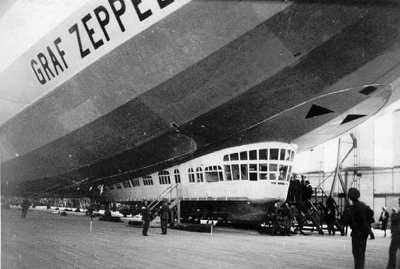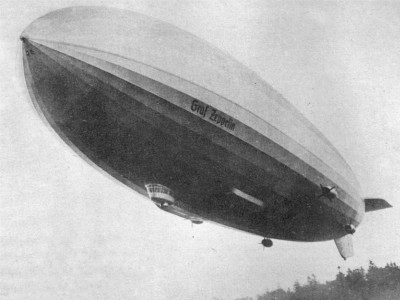The Zeppelin Airships
Part Three: The Giant Zeppelins 1918 - 1940
LZ-120 Bodensee | In Italy: Esperia |
Class: |
Type Y |
Usage: |
DELAG; war reparations to Italy |
First Flight: |
20 August 1919 |
Length: |
229.1 feet / 130.8 meters |
Diameter: |
61.4 feet / 18.7 meters |
Gas Volume: |
22,550 cu. meters |
Engines: |
Four Maybach Mb IVa, 245 hp 6-cylinder inline engines |
Maximum Speed: |
82 mph / 132 kph |
Crew: |
16 |
Passengers: |
20? |
 |
LZ-120 Bodensee was the first passenger zeppelin constructed since the Sachsen in 1913. Both Bodensee and her sister ship LZ-121 Nordstern were an adaptation of the "Height-Climber" class. She was built for the specific purpose of small-scale passenger flights, and it was hoped that these would provide needed publicity for future undertakings. She included a first-class passenger section and was flown by DELAG until 1921. She was transferred to Italy as a war reparation in July of 1921 and renamed Esperia. She was based at Ciampino near Rome and was used primarily by the military. She was still occasionally flown as a passenger ship until the Italians broke her up for scrap in July of 1928.
|
LZ-121 Nordstern | In France: Méditerranée |
Class: |
Type Y |
Usage: |
DELAG; war reparations to France |
First Flight: |
13 June 1921 |
Length: |
229.1 feet / 130.8 meters |
Diameter: |
61.4 feet / 18.7 meters |
Gas Volume: |
22,550 cu. meters |
Engines: |
Four Maybach Mb IVa, 245 hp 6-cylinder inline engines |
Maximum Speed: |
82 mph / 132 kph |
Crew: |
16 |
Passengers: |
20? |
 |
LZ-121 Nordstern was intended for regular flights to Stockholm. Almost immediately after her first test flight, she was siezed by the Allies and transferred to France as a war reparation.
|
LZ-122 |
Not delivered - construction cancelled due to the Treaty of Versailles.
|
LZ-123 |
Not delivered - construction cancelled due to the Treaty of Versailles.
|
LZ-124 |
Not delivered - construction cancelled due to the Treaty of Versailles.
|
LZ-125 |
Not delivered - construction cancelled due to the Treaty of Versailles.
|
LZ-126 USS Los Angeles |
Usage: |
experimental prototype;
war reparations to United States |
Designation: |
ZR-3 |
First Flight: |
27 August 1924 |
Length: |
658 feet / 200 meters |
Gas Volume: |
2,472,000 cu. feet |
Maximum Speed: |
76 mph / 122 kph |
 |
The Treaty of Versailles effectively prohibited the manufacture of large airships in Germany. Desperate to save the company, Dr. Hugo Eckener, chairman of Zeppelin, entered into negotiations with the government of the United States. The result was LZ-126, the largest zeppelin yet, built specifically as war reparations, paid for by the new German Republic. Lovingly handcrafted by the Zeppelin workers who feared that this would be their last airship, LZ-126 became the most reliable American airship ever. Dr. Eckener himself piloted her to Lakehurst, crossing the Atlantic in 81 hours and 2 minutes, arriving on 15 October 1924.
|  |
She was christened ZR-3 Los Angeles in November of 1924 by Mrs. Calvin Coolidge and included in the list of active ships of the US Navy. She remained in service until 1932. After being mothballed for just a year, she was put back into active duty until 1940. She made 331 flights and accumulated 5,368 hours of flight time.
|
LZ-127 Graf Zeppelin |
Usage: |
DELAG / DZR |
First Flight: |
18 September 1928 |
Length: |
776 feet / 236.53 meters |
Diameter: |
100 feet / 30.48 meters |
Gas Volume: |
3,700,000 cu. feet / 111,000 cu. meters |
Engines: |
Five 550 hp Maybach engines |
Maximum Speed: |
80 mph / 128 kph |
Crew: |
? |
Passengers: |
? |
 |
LZ-127 Graf Zeppelin was inarguably the most successful, and most popular, airship in history. The sight of her gliding overhead brought crowds of people streaming into the streets. She was Dr. Eckner's crowning achievement in the concept of the zeppelin. Even though Hindenburg and Graf Zeppelin II would be technologically superior, no other airship would be so loved all over the world.
Many innovations were incorporated into the Graf, the most revolutionary of which was a new fuel system for the engines. Special gas cells were installed below the hydrogen lifting cells. These new cells filled approximately one third of each bay within the ship and contained a new fuel called "Blau gas". Invented by Dr. Hermann Blau, this gaseous fuel weighed about as much as air. As the fuel burned, no weight was lost by its consumption as was the case with traditional (gasoline or diesel) fuels. |
 |
The Depression in Germany made money scarce, and it had taken a plea to the German people by Dr. Eckener to raise most of the money to have her built. The money to keep her flying came in the form of an angel: airship enthusiast William Randolph Hearst. Hearst financed a circumnavigation of the globe in return for exclusive U.S. rights to the story. The 1929 global flight began in Friedrichshafen and proceed to Lakehurst, New Jersey. Lakehurst marked the "official" starting point of the journey. From Lakehurst the Graf flew back to Friedrichshafen, across Siberia to Tokyo, and then across the northern Pacific to San Francisco, Los Angeles and back to Lakehurst. Although the Graf was not the first aircraft to circle the globe, it was by far the fastest. What took months for a British heavy bomber to do, with many breakdowns and hardships, the Graf did in only 12 days in comfort and style with a full complement of passengers over much previously uncharted land. The trip was a complete success and the world, particularly the U.S., caught Zeppelin mania. Zeppelin struck a deal with Goodyear to produce larger airships for the trans-Atlantic routes. |
 |
Graf Zeppelin continued her career with regular passenger flights to North and South America. She made an Arctic trip in 1931 that included a rendezvous with a Soviet icebreaker. She was retired in 1937 following the Lakehurst disaster and destroyed in 1940 at the order of Hermann Göring.
|
LZ-128 |
Not delivered - construction cancelled in favour of LZ-129.
|
LZ-129 Hindenburg |
Class: |
Hindenburg |
Usage: |
DELAG / DZR |
First Flight: |
4 March 1936 |
Length: |
804 feet / 245.06 meters |
Diameter: |
135 feet / 41.15 meters |
Gas Volume: |
7,063,000 cu. feet / 211,890 cu. meters |
Engines: |
Four 1200 hp Mercedes Benz engines |
Maximum Speed: |
84.4 mph / 135 kph |
Crew: |
? |
Passengers: |
? |
 |
LZ-129 Hindenburg was a marvel of zeppelin engineering and design. With her massive diameter and her impressive length, the Hindenburg would carry a gas volume of 7,062,000 cubic feet, producing an astounding 242.2 tons of gross lift. The useful lift (after subtracting the weight of the structure) was still 112.1 tons. |
 |
 |
Hindenburg was a first in many ways for the Luftschiffbau Zeppelin. Her design was a departure from old ships and carried many novelties. She carried all passengers inside her huge hull instead of from a protruding gondola section. Her control car alone disturbed her smooth lines.
The new Nazi government clashed repeatedly with Dr. Eckener, who made no secret of his loathing for the party. DELAG was nationalized as DZR (Deutsche Zeppelin-Reederei). Over Eckener's protests, zeppelins would now prominently display the Nazi swastika on their fins and occasionally tour Germany to indoctrinate the people with march music and Nazi propaganda speeches from the air. Apart from the propaganda missions, her commercial service consisted of regular passenger flights to North and South America. Hindenburg was designed for filling with helium gas instead of flammable hydrogen - an airship first. Unfortunately, the American government changed their policy and refused to sell helium to Zeppelin. As a result, the Nazi government ordered the ship filled with explosive hydrogen, despite her not having all of the fire-retardant materials and construction of earlier airships. |
 |
The result was, perhaps, inevitable. On 6 May 1937, LZ-129 Hindenburg exploded at Lakehurst New Jersey, killing 35 of the 97 people on board and one member of the ground crew.
|
LZ-130 Graf Zeppelin II |
Class: |
Hindenburg |
Usage: |
DZR / military |
First Flight: |
14 September 1938 |
Length: |
804 feet / 245.06 meters |
Diameter: |
135 feet / 41.15 meters |
Gas Volume: |
7,063,000 cu. feet / 211,890 cu. meters |
Engines: |
Four 1200 hp Mercedes Benz engines |
Maximum Speed: |
84.4 mph / 135 kph |
Crew: |
50 |
Passengers: |
100 |
 |
LZ-130 Graf Zeppelin II was the last of the great airships.
Following the shake-down trials of her sister ship, LZ-129 Hindenburg, the Zeppelin engineers incorporated numerous engineering and design improvements in her construction. She was designed to carry up to 100 passengers with a crew and wait staff of 50. |
 |
After the Lakehurst disaster, she was modified for helium inflation and an assigned passenger capacity of only 40, although the reconfigured passenger cabins were roomier, had better lighting, and included four luxury cabins.
After the American government refused to supply helium to the Germans, Graf Zeppelin II flew using hydrogen between 14 September 1938 and 22 August 1939. |
 |
With the outbreak of war, she was laid up in Hangar #2 at Rhein-Main Airfield in Frankfurt. Together with the original LZ-127 Graf Zeppelin, she was cut up for scrap in March 1940.
|
LZ-131 |
Not delivered - construction cancelled.
|
Copyright ©2007 Puget Sound Airship Society
|
 |
|
